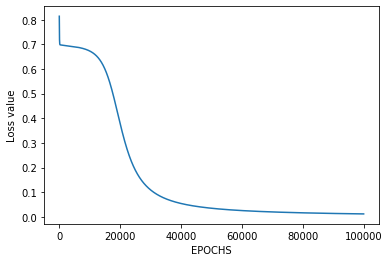2位二进制输入XNOR逻辑门的人工神经网络实现
人工神经网络(ANN)是一种基于动物大脑的生物神经网络的计算模型。 ANN 用三种类型的层建模:输入层、隐藏层(一个或多个)和输出层。每层都包含节点(如生物神经元),称为人工神经元。所有节点都通过两层之间的加权边(如生物大脑中的突触)连接。最初,使用前向传播函数预测输出。然后通过反向传播,更新节点的权重和偏差以最小化预测误差,从而在确定最终输出时达到成本函数的收敛。
2位二进制变量的XNOR逻辑函数真值表,即输入向量和相应的输出
![]() –
–![]()
![]()
![]()
0 0 1 0 1 0 1 0 0 1 1 1
Approach:
Step1: Import the required Python libraries
Step2: Define Activation Function : Sigmoid Function
Step3: Initialize neural network parameters (weights, bias)
and define model hyperparameters (number of iterations, learning rate)
Step4: Forward Propagation
Step5: Backward Propagation
Step6: Update weight and bias parameters
Step7: Train the learning model
Step8: Plot Loss value vs Epoch
Step9: Test the model performance
Python实现:
Python3
# import Python Libraries
import numpy as np
from matplotlib import pyplot as plt
# Sigmoid Function
def sigmoid(z):
return 1 / (1 + np.exp(-z))
# Initialization of the neural network parameters
# Initialized all the weights in the range of between 0 and 1
# Bias values are initialized to 0
def initializeParameters(inputFeatures, neuronsInHiddenLayers, outputFeatures):
W1 = np.random.randn(neuronsInHiddenLayers, inputFeatures)
W2 = np.random.randn(outputFeatures, neuronsInHiddenLayers)
b1 = np.zeros((neuronsInHiddenLayers, 1))
b2 = np.zeros((outputFeatures, 1))
parameters = {"W1" : W1, "b1": b1,
"W2" : W2, "b2": b2}
return parameters
# Forward Propagation
def forwardPropagation(X, Y, parameters):
m = X.shape[1]
W1 = parameters["W1"]
W2 = parameters["W2"]
b1 = parameters["b1"]
b2 = parameters["b2"]
Z1 = np.dot(W1, X) + b1
A1 = sigmoid(Z1)
Z2 = np.dot(W2, A1) + b2
A2 = sigmoid(Z2)
cache = (Z1, A1, W1, b1, Z2, A2, W2, b2)
logprobs = np.multiply(np.log(A2), Y) + np.multiply(np.log(1 - A2), (1 - Y))
cost = -np.sum(logprobs) / m
return cost, cache, A2
# Backward Propagation
def backwardPropagation(X, Y, cache):
m = X.shape[1]
(Z1, A1, W1, b1, Z2, A2, W2, b2) = cache
dZ2 = A2 - Y
dW2 = np.dot(dZ2, A1.T) / m
db2 = np.sum(dZ2, axis = 1, keepdims = True)
dA1 = np.dot(W2.T, dZ2)
dZ1 = np.multiply(dA1, A1 * (1- A1))
dW1 = np.dot(dZ1, X.T) / m
db1 = np.sum(dZ1, axis = 1, keepdims = True) / m
gradients = {"dZ2": dZ2, "dW2": dW2, "db2": db2,
"dZ1": dZ1, "dW1": dW1, "db1": db1}
return gradients
# Updating the weights based on the negative gradients
def updateParameters(parameters, gradients, learningRate):
parameters["W1"] = parameters["W1"] - learningRate * gradients["dW1"]
parameters["W2"] = parameters["W2"] - learningRate * gradients["dW2"]
parameters["b1"] = parameters["b1"] - learningRate * gradients["db1"]
parameters["b2"] = parameters["b2"] - learningRate * gradients["db2"]
return parameters
# Model to learn the XNOR truth table
X = np.array([[0, 0, 1, 1], [0, 1, 0, 1]]) # XNOR input
Y = np.array([[1, 0, 0, 1]]) # XNOR output
# Define model parameters
neuronsInHiddenLayers = 2 # number of hidden layer neurons (2)
inputFeatures = X.shape[0] # number of input features (2)
outputFeatures = Y.shape[0] # number of output features (1)
parameters = initializeParameters(inputFeatures, neuronsInHiddenLayers, outputFeatures)
epoch = 100000
learningRate = 0.01
losses = np.zeros((epoch, 1))
for i in range(epoch):
losses[i, 0], cache, A2 = forwardPropagation(X, Y, parameters)
gradients = backwardPropagation(X, Y, cache)
parameters = updateParameters(parameters, gradients, learningRate)
# Evaluating the performance
plt.figure()
plt.plot(losses)
plt.xlabel("EPOCHS")
plt.ylabel("Loss value")
plt.show()
# Testing
X = np.array([[1, 1, 0, 0], [0, 1, 0, 1]]) # XNOR input
cost, _, A2 = forwardPropagation(X, Y, parameters)
prediction = (A2 > 0.5) * 1.0
# print(A2)
print(prediction)输出:

[[ 0. 1. 1. 0.]]在这里,每个测试输入的模型预测输出与 XNOR 逻辑门常规输出完全匹配( ) 根据真值表,成本函数也在不断收敛。
因此,这意味着 XNOR 逻辑门的人工神经网络已正确实现。